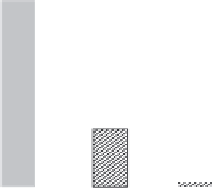Biomedical Engineering Reference
In-Depth Information
0,80%
0,60%
0,40%
0,20%
0,00%
EVA
PA6
PP
FIGURE 14.4
Spontaneous release during weathering with rain cycles: the solid content of
collected run-off water increases for nanocomposites with low compatibility between nano-
filler and matrix. (Adapted from Busquets-Fite, M. et al., Exploring release and recovery of
nanomaterials from commercial polymeric nanocomposites, Institute of Physics.)
To explore the relation between spontaneous release and induced release, and
to assess the origins of the variation, a pilot interlaboratory comparison was per-
formed in the frame of the nanoGEM project between Leitat, NIST, and BASF,
to simulate and detect aging and release of 4% hydrophobized SiO
2
from PA
nanocomposites (Wohlleben et al. 2014). Both induced release by mechanical
shear after dry weathering and spontaneous release during wet weathering were
investigated at different UV intensities. For induced release, irradiated specimens
between 10 and 50 cm² were immersed in a minimal volume of water (below 10 ml)
to maximize signal-to-noise from released fragments. The forces to induce release
were gradually increased from 24 h immersion (interfacial forces only) to 24 h
shaking (assumed to be closest to reality), to 1 h ultrasound bath (as worst-case
estimate). The SEM and TEM evaluation of fragments in run-off water (spontane-
ous release, identical protocol to the NanoPolyTox results reported earlier) and of
fragments in immersion fluids (induced release) were qualitatively the same with
respect to complex geometrical shapes and chemical compositions, ranging from
polymer fragments with embedded or bound SiO
2
to occasional observations of
pure polymer or pure nanofiller (Figures 14.5e through 14.5g). Given the coexist-
ing morphologies and high polydispersity, a statistically significant quantifica-
tion of fragments is difficult. Centrifugation methods were developed (Wohlleben
2012) and applied to size-selective quantification of release. By reference to the
irradiated surface area that was immersed, values of mg fragments released from
m² irradiated surface can be extracted. The amount of fragments with less than
150 nm diameter, where free SiO
2
would appear, grew with the UV irradiance, and
was grossly consistent between laboratories, (Wohlleben et al. 2014). However,








Search WWH ::

Custom Search